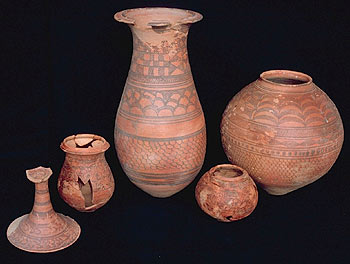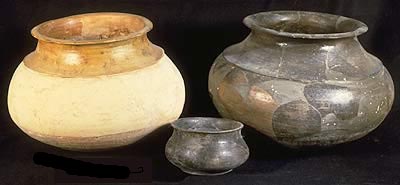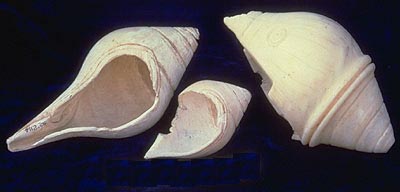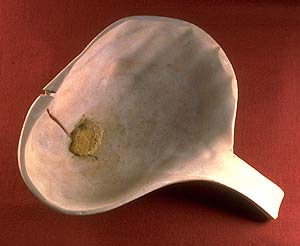|
 |
keeping you - |
AWARE OF THE PAST
ABREAST OF THE PRESENT
ALERT ABOUT THE FUTURE |
|
 |
| |
| POTTERY |
| |
|
| |
|
Three Vessels
Three vessels of the Late Harappan Cemetery H period (after 1900 BC). In the center is a small painted globular pot from a burial group. These forms and their surface treatments are quite distinct from the characteristics of the preceding Harappan Period.

|
|
|
| |
|
Ravi Phase Cooking Pot
Cooking pots during the Ravi Phase were made in large globular shapes that had a low center of gravity to keep them from tipping over when filled with food. In order to protect the fine clay from cracking due to the heat of the fire, the exterior was covered with a slurry of coarse sandy clay mixed with calcium carbonate nodules and some pebbles.

|
|
|
| |
|
Ravi Phase Pot
This Ravi Phase hand-built pot is having polychrome design. The net and bird motifs are found at other sites to the northwest in Bannu district, but they do not continue into the later Kot Diji and Harappa Phases.

|
|
This type of polychrome pottery from the lowest (earliest) levels at Harappa was made around 3300 B.C., before the advent of the Indus Civilization. The pottery was made completely by hand (rather than on a wheel). The designs are painted in shades of white, red and black. The motif of intersecting circles (shown in an early somewhat disjointed form) on the left pot was refined and continued as a popular motif in the pottery of the Indus Civilization. The waterfowl painted on the right pot were probably part of a familiar scene at Harappa, which was located near the Ravi River.

|
|
|
|
| |
|
Decorated pottery
Much of the pottery was undecorated, but some vessels were decorated with red slip over much of the surface. In addition, some vessels were decorated with plant and animal motifs such as pipal leaves, peacocks, ibex and geometric designs painted in black.

|
|
Ravi Phase Pottery Fragments
All pottery from the first part of the Ravi Phase was hand built. Most of the forms were finely made shallow bowls, deep bowls, narrow-mouthed carinated vessels, or thick walled cooking pots.

|
|
|
|
| |
|
Hand-built Pot
Dating to c. 3100 BC, this hand-built pot with polychrome decoration is one of the earliest examples of intersecting circle motif in the Indus valley region. This motif along with others, such as the fish scale and pipal leaf designs, continue to be employed into the later Kot Diji and Harappa Phases.

|
|
|
| |
|
Large Burial Urn
Late Harappan Period large burial urn with ledged rim for holding a bowl-shaped lid. The painted panel around the shoulder of the vessel depicts flying peacocks with sun or star motifs and wavy lines that may represent water. Cemetery H period, after 1900 BC. These new pottery styles seem to have been introduced at the very end of the Harappan Period. The transitional phase at Harappa has begun to yield richly diverse material remains suggesting a period of considerable dynamism as socio-cultural traditions became realigned.

|
|
|
| |
|
Small pot
A small pot dating to the Period 3C of the Harappa Phase (c. 2200-2000 BC) was found in excavations on Mound E in 1998. This tiny pot contained fired steatite beads similar to those made during the Ravi Phase as well as faience beads and beads made from the seed of a plant that is commonly called "Job's Tears"

|
|
|
| |
|
Painted Burial Pottery
Painted burial pottery from Harappa. The two largest vessels were found in the same burial and are described below. The other smaller vessels were found in an earlier burial and represent an older style of pottery.
Tall jar with concave neck and flaring rim:
The rounded base was originally supported in a ring stand. The black painted geometric designs are arranged in panels with a red slip as background. After initial firing, the entire painted design was obliterated with a red slip and fired again at a low temperature that turned the exterior layer of the slip red through oxidation, but the inner layer remained gray. This overslip was not well bonded to the previously slipped surface and was partially eroded when first discovered. After initial conservation and documentation, one half of the overslip was removed to reveal the original painted design. The lid and ring stand with this vessel were also covered with an overslip. This tall jar was located at the foot of the burial pit for burial 148a.
Material: terra cotta
Dimensions: jar - 62.8 cm height, 32.4 cm dia.; lid - 8.9 cm height, 28.2 cm dia.
Harappa, Lot 145 Harappa Museum, jar H87-655; lid, H87-657
Dales 1991: 64, fig. 5.2; Dales and Kenoyer 1991: fig. 13.17
Large globular painted pot:
A large globular vessel with lid and ring stand was located at the head of the same burial. It was made in several stages, beginning with a molded base and then built up in two or three stages on the wheel. Other unslipped vessels were associated with these two uniquely treated burial vessels.
With geometric designs arranged in panels, and found in the same burial as the tall painted jar, this vessel also had a second layer of red slip that totally obliterated the painted design. The same treatment was done to the lid and ring stand. This large pot was made on the wheel in several stages and has a molded base. The lid was made in a mold on the wheel and then the knob was attached, also on the wheel. The ring stand was thrown on the wheel and then carved to hollow out the base.
Material: terra cotta
Dimensions: pot - 44.4 cm height, 43.8 cm max dia.; lid - 6.6 cm height, 22.5 cm dia.; ring stand - 12 cm height, 20.2 cm dia.
Harappa, Lot 145
Harappa Museum, pot, H88-1121/145-28; lid, H88-993/145-29; ring stand, H88-992/145-19
Dales 1991: 64; Dales and Kenoyer 1991: fig. 13.17

|
|
Burial Pottery
Collection of burial pottery without any painted designs. These vessels come from one of the later burials towards the end of the Harappan period, possibly dating to 1900 B. C.

|
|
|
|
| |
|
Below is a group of pottery vessels found in a grave at Harappa. The variety of forms probably indicates a variety of functions such as storing water, milk or crops and serving food. The local Harappan potters manufactured a large array of specialized pottery.

|
|
|
| |
|
Reconstructed Pottery
Collection of reconstructed pottery from the late levels. These shapes include the final Harappan forms (late Period 3C) and transitional Late Harappan period shapes (Period 4).

|
|
|
| |
|
Pointed Base Goblets
The pointed base results from rapid manufacture off a fast wheel and makes it easy for stacking in the kiln. The grooves around the body may serve as a simple decoration, but they also allow for a better grip.
Found only in the largest cities and towns, these cups appear to have been used once and then tossed away, as is the case with disposable terra cotta cups in the cities of Pakistan and India today. Some of these disposable drinking cups have a seal impression on the shoulder or base and may have been made for specific owners or for specific rituals. Wheel thrown off the hump and string cut base.

|
|
|
| |
|
Cooking Vessel
Ledged cooking vessel with high neck and flaring rim. This metal vessel is almost identical to many terra cotta cooking vessels and was probably intended for a very wealthy family. It was made by hammering a sheet of copper and raising the hollow base and rim separately. The two pieces were joined together with cold hammering at the ledge. This vessel contained a hoard of copper weapons and tools.
Material: copper/bronze
Dimensions: 16.5 cm height, 21 cm max. dia.
Harappa, No. 277, 13 303 B
National Museum, Karachi, NMP 52.3214.
Vats 1940: 85, 384.

|
|
Plate
Plate with vertical sides. Copper and bronze plates were probably used exclusively by wealthy upper class city dwellers.
Material: copper/bronze
Dimensions: 4.3 cm height, 30.3 cm dia.
Mohenjo-daro, DK 10781A
National Museum, Karachi, NMP 52.1028
Mackay 1938: CXVIII, 20

|
|
|
|
| |
|
Cooking Pots, Nausharo
Ledge shouldered cooking pots with low neck and flaring rim. One vessel has red slip on the neck and rim, while the other is fired grey-black. A small black fired bowl is seen in the foreground. Period III, Harappan, 2300-2200 B. C.
Material: terra cotta.
Dimensions: 20 cm height, 28 cm max dia.
Nausharo [Baluchistan], NS P7E, XVII /99.
Department of Archaeology, Karachi, EBK 5654.

|
|
|
| |
|
Libation Vessels
Libation vessels made of the conch shell Turbinella pyrum. One of these is decorated with vermilion filled incised lines. A single spiraling design is carved around the apex and a double incised line frames the edge of the orifice. This type of vessel was used in later times for ritual libations and for administering sacred water or medicine to patients.
Material: marine shell, Turbinella pyrum
Dimensions of the left vessel: 11.4 cm length, 5.4 cm width, 4.7 cm height.
Mohenjo-daro, DK 8538
Mohenjo-daro Museum, 52.2114, MM5073
Kenoyer 1983: 183-4, fig. 3-15, 5.

|
|
Shell Ladle
Large ladle found with burial pottery in a disturbed burial of the Harappan cemetery. Shell ladles were probably used in special rituals for dispensing sacred liquids such as water or oil. A hole in the bottom of the ladle has been repaired with a lead rivet. Corrosion and expansion of the lead has caused the shell to crack.
The fact that this object was included with the burial goods indicates that it must have had an important role in the after life or perhaps it could not be passed on to others due to its strong personal association with the dead individual. No complete burial was associated with this object so it is not possible to determine if it was used by a man or a woman.
Material: marine shell, Chicoreus ramosus
Dimensions: 24.3 cm length, 16.4 cm width
Harappa, Lot 446-01
Harappa Museum, H88-1192
Dales and Kenoyer 1990: 81, figs. 31, 58

|
|
|
|
| |
|
| |
|
| |
|
|